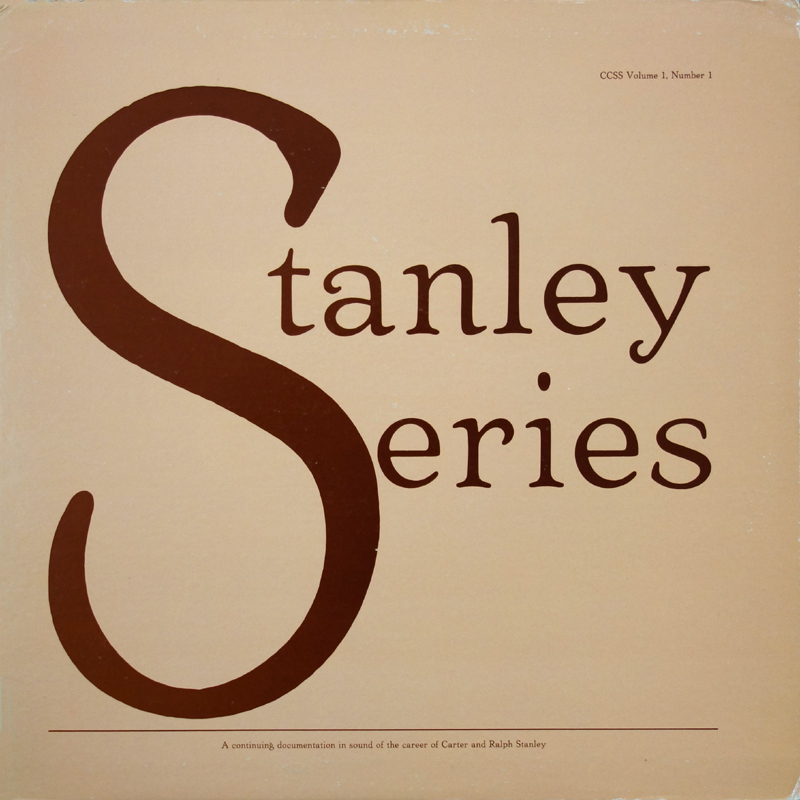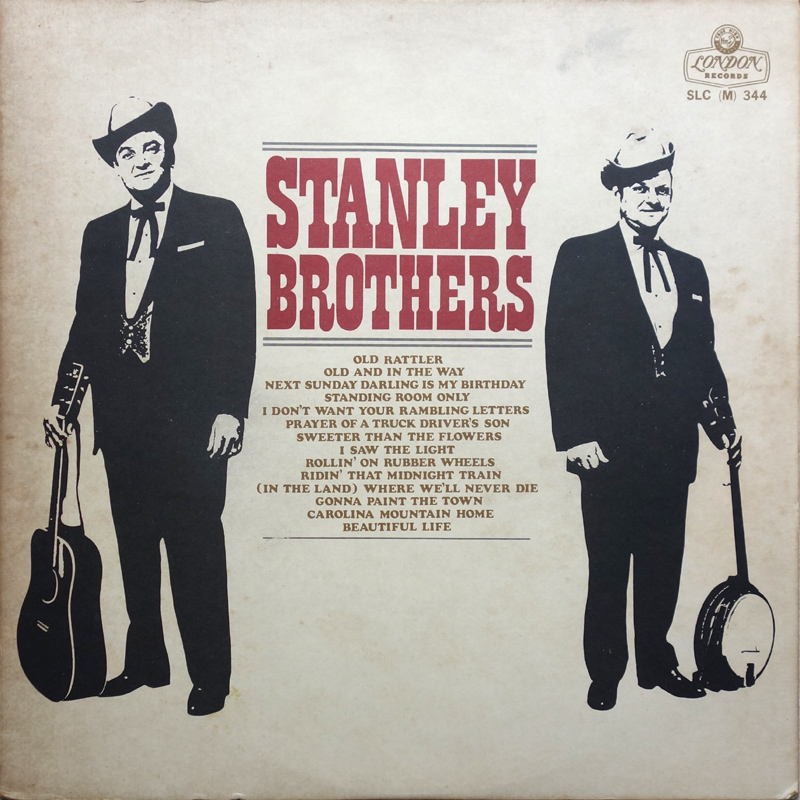- Bill Gatton Chevy Show
- Carter Stanley Interview - 1966
- How Far To Little Rock? - Search live shows
- Jim Kent's film 'Ralph Stanley's Bluegrass Festival'
- New WCYB Recording
- Pound Va. 1972 - Video
- Replica Rebel T-Shirt
- R.I.P. Ralph
- Roy Lee Centers Last Show
- Song & Memory Books
- Stanley Brothers - WCYB Acetate
- Stanley Standard - Carter Stanley Memorial Issue
- Suwannee River Jamboree
- Up In The Cloud - 1957-62
Stanley Style Banjo - A Primer
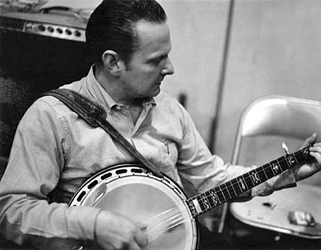
I'd been learning banjo for a while when I started gravitating towards the sound of Ralph's playing, but frustratingly there seemed to be very little instructional material that dealt with his style of picking, and which was geared to novices like myself..
After a couple of years of searching I found a copy of John Wright's "5-String Banjo Stanley Style" booklet[1] and that proved to be the eureka moment, the turning point where my attempts at picking finally started to sound a bit more like Ralph!
In particular the section at the beginning of the John Wright's booklet, is I think, the best and clearest explanation of the basics of Ralph's banjo style.
John Wright graciously has given us permission to reproduce the booklet material so I've retyped John's notes from the second edition below, and you can also download these pdf scan's:
- 1st Edition - 1984 (20.8 Mb)
- 2nd Edition - 1988 (11.9 Mb)
NB: To download the files, I'd recommend using the 'right-click' and 'Save Link As' method, due to their size... Both contain scans of the booklets, which have mostly different selection of tabs. The '1988 editon' pdf has a different cover to the one I bought, but the content is the same.
We will be adding much more on Ralph's 'Stanley Style' in due course, but in the meantime for anyone looking for other resources, here's some other material worth checking out:-
- The Banjo Outlaw's youtube channel has several excellent videos on the Stanley style by Heith Efird aka 'Pick1949' from the Banjo Hangout. Be sure to check his Setup and Playing tips video!
- Stanleytone (Gary Bates) also on the Banjo Hangout has a awesome collection of really accurate Stanley tabs.
- The Banjo Newsletter - Again lots of Ralph related material.
- The Banjo Of Ralph Stanley: From Old-Time To Bluegrass - DVD
- Steve Sparkman - Stanley Style Banjo - DVD
Thanks again to John Wright for making his booklets available and to Henry Torrie for sending in the files and suggesting we put them on-line.
As a young boy in Dickenson County, Virginia, Ralph Stanley first started playing the banjo in the old clawhammer style, which he learned from listening to the music of his mother, Lucy Smith Stanley, who had been an accomplished banjo player since her childhood. A little later he picked up the two-finger (actually finger and thumb) style which was being used at the time by professional musicians such as Wade Mainer or Mainer's Mountaineers.
When Ralph returned from service in the army in October, 1946, he found that his brother Carter had arranged for the two of them to fulfill their lifelong ambition of becoming professional musicians. He also found that a new style of banjo playing, the three finger roll, was becoming popular. Snuffy Jenkins, his nephew Hoke, and Johnnie Whisnant (all from North Carolina) were the first musicians Stanley heard playing this style, and Earl Scruggs was popularizing it over a wide area through his broadcasts on the Grand Ole Opry with Bill Monroe and the Blue Grass Boys.
Learning three-finger banjo is one of he most notoriously difficult tasks in country music, and even the most ambitious musician would need a bit of a spur in order to undertake it. While later stories that circulated to the effect that Carter Stanley put Ralph in a room with a few Scruggs records and told him not to come out until he had learned the style are surely an exageration, there is no doubt that the success of Earl Scruggs was a major factor in inspiring Ralph Stanley to take up three-finger picking. ("Earl Scruggs", he says, "has always been my favorite banjo player".) He also liked the sound of it. "As the music advanced", he explained years later, "I thought I should advance with it. It was a better style and it was a better beat and all that."
Since Stanley already knew music - melody, harmony, chord patterns, etc - and since his left-hand technique was already thoroughly developed, he started out with an excellent foundation for learning. Furthermore, it is virtually impossible to play clawhammer banjo without developing a solid sense of rhythm - a vital factor in any style of banjo playing - and Stanley's version of two-finger playing demanded an extraordinarily nimble index finger, which was to stand him in good stead as he created his unique version of three-finger play. Working professionally with a full band while he learned was no doubt very useful as well, especially for his timing and his general sense of the proper place of the banjo in an ensemble. He continued to feature clawhammer and two-finger picking at the Stanley Brothers' performances, and at the same time he worked on the new style, sometimes practicing in the back of the car as the group traveled from show to show. Asked recently how he developed three-finger picking, Stanley style, he replied, "Well, I don't think I could put that in words. Tried to copy a little bit here and there. I never could. I just played it the way that my fingers led me. Couldn't play it any other way".
The way that Ralph Stanley's fingers led him turned out to produce the simplest and most straightforward three-finger style of any of the big-time banjo players. It consists almost entirely of only three basic patterns. The first and most important of these has no generally accepted name:

It is true that one variation of this pattern is known to some banjo players as the "Foggy Mountain Breakdown" roll:

And Stanley uses that variation often enough. But for the five-string banjo, Stanley style, it would probably be best to call this the "Long Journey Home" roll, since Stanley's version of that tune (long the Stanley Brother's theme tune) consists almost entirely of this pattern - 14 out of 16 measures, starting with the following:

In 1963 Earl Scruggs recorded a version of this tune, and produced a characteristically smooth, flowing sound by playing the third measure as follows:

The third measure in Stanley's version, recorded at about the same time, is quite different:

The result, when coupled with the first two measures, is more insistent, more percussive, a kind of tambourine-thumping (and Stanley, by the way, is an accomplished tambourine player).
It should be noted that the order of this roll can be reversed, as in the following example:

and that the index finger, rather than the fumb, is often used for the leading notes, even when these are on the fourth string:
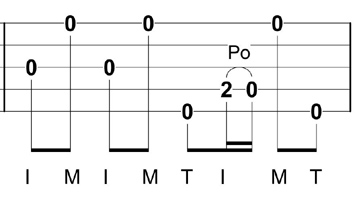
- a characteristic Stanley lick for trailing off a break. It is perfectly possible to play many tunes using virtually nothing but this roll, and there are quite a few banjo players in the Appalachian area, many of them no doubt heavily inluenced by Stanley, who do just that. The repeated "thump-thump" of those initial notes is a dead giveaway.
The next most common pattern used by Stanley is generally known as the forward roll:
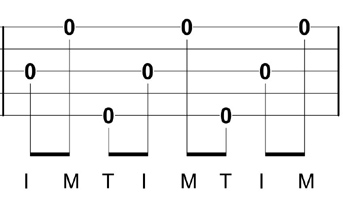
Once again, the index finger is all-important:
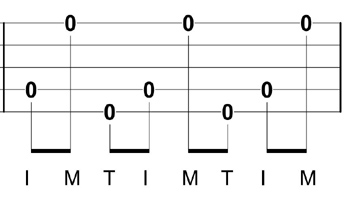
This simple roll can produce a wide variety of sounds, especially when the left hand is brought into play:
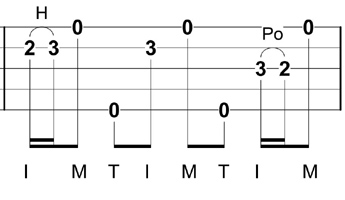
Some very simple variations can produce quite startling effects; for instance, when the roll is begun on the thumb string:
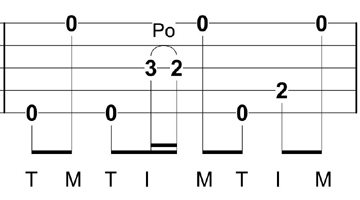
or when most of the roll is played on the first string, as in this example from Let's Go To The Fair (it would be hard to imagine any other player wrenching the melody out of the banjo in quite this way; see also the break to Little Glass Of Wine):
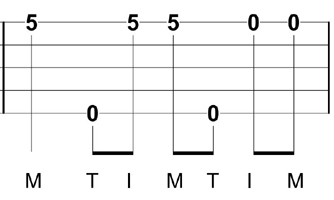
The forward roll is often combined with the "Long Journey Home" roll, in one order:

or another (producing a mild bit of syncopation):

These two rolls are really just variations on the same thumb-index-middle pattern. But the tag lick, or reverse roll, is fundamentally different:
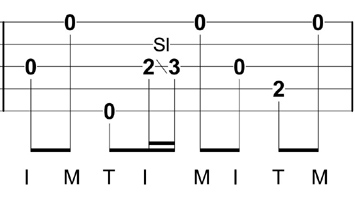
Especially in backup work, Stanley will often use the following variation of the reverse roll, bringing his thumb in to the bass string:
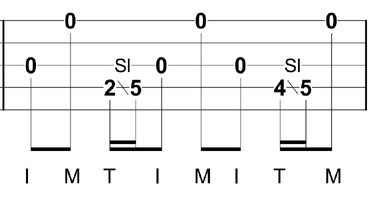
In any given lead break the "Long Journey Home" roll is generally used for at least 60 percent of the measures; forward and reverse rolls are used in varying proportions for the remaining measures depending on the nature of the melody. The three rolls account for almost all the notes; apparent exceptions, such as the following:

usually turn out to be new combinations of the three rolls (in the above case the first and third) in which the identities of the rolls are concealed by the bar lines of tablature. Problems with the rolls can arise when several consecutive notes must be played on the first string; usually Stanley will just play such notes individually, often with pinches:
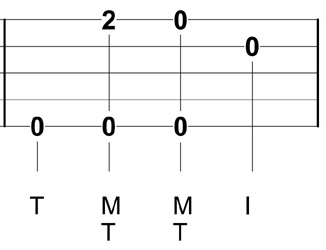
Finally, instead of using the usual square roll (or "thumb-in-and-out" roll) when he wants two strong slides on the two beat notes, Stanley will do the following (once again leading off with the index finger):
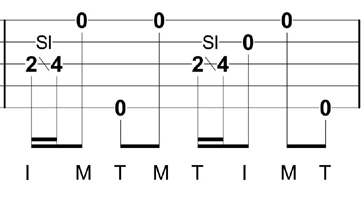
Ralph Stanley's backup work (for standard breakdown tunes at least) has tended to become very simple and reticent in recent years. Besides plain rhythmical slaps:
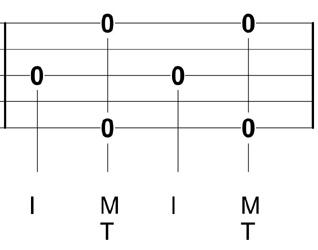
and the runs on the bass string mentioned earlier (see Paddy On The Turnpike), it consists mainly of the following choke lick:[2]

which is played equally often behind the tonic (I) or dominant (V) chords. (While doing this choke Stanley keeps both index and ring fingers of his left hand on the third string [frets 12 and 14], treating them as a unit: a useful left-hand technique for much down-the-neck- work as well).
Just about any of the combinations listed here could be found in the musical vocabulary of most contemporary banjo players (though only rarely in the variations for which the index finger is used on the bass string), Ralph Stanley's individuality consists in his virtually exclusive concentration on them. He is what in the world of art would be called a minimalist; it is easier to define his work by what he does not do than by what he does. He does not, as he would say, "play all around it." He does not use chromatic runs or elaborate chord progressions; indeed, he often comes close to playing with no chords at all, reducing the first string as well as the fifth to a drone. He seldom uses parterns that produce syncopapted melody notes, and he avoids (or downplays) flatted thirds and other sounds characteristic of the blues. In a recent recording of Sitting On Top Of The World, Earl Scruggs played the following for the third measure:
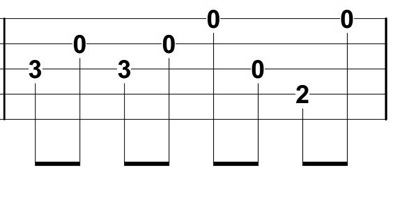
Stanley's third measure for the same tune, also done in a recent recording, went as follows:
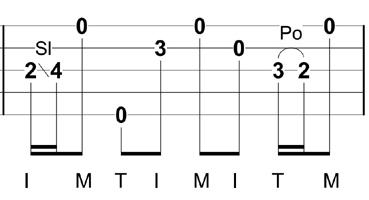
The slide produces a more mountainy, less bluesy sound.
Any banjo player worth listening to has a good sense of rhythm, and many contemporary banjo players will use that sense to play around the rhythm, falling behind, almost imperceptibly, and then catching up as part of the total sound of the groups they play in. But Ralph Stanley concentrates on laying down a strong, unmistakable beat in every part of every measure. Most modern players use their breaks to create variations on the basic melody, but Stanley does his best to reproduce in his breaks every note, in fact every grace note, of the melody just exactly as it is sung. And while a booming full-throated tone is the goal of most banjoists, Stanley accentuates the percussive quality of his instrument by playing, as musicologists say, "sul pointicello" (that is, as close to the bridge as possible) and by playing on archtop banjos exclusively.[3]
Stanley's banjo style has remained remarkably consistent over his four decades as a professional, but naturally there have been changes, some positive, some negative, most of which date from the time when he started working solo after his brother Carter's death in 1966. Gone are the elaborate bluecgrass clichés for winding up a break or a song (cf. the early Handsome Molly); Stanley will now stop a number quite abruptly: a kind of showmanship in itself. And as his own master of ceremonies, Stanley no longer has time for the complicated adjustments needed to play D-tuning instrumentals like Hard Times. In fact (much to the regret of banjo lovers), instrumentals as a whole have gone by the boards lately, and a decade has passed since Stanley, who now prefers to concentrate on his singing, has composed a new one.
The problem of retuning, however, has not deterred Stanley from featuring clawhammer picking more and more. At one time he astonished Mike Seeger by demonstrating four different right-handed clawhammer licks on the same tune, all of which, to Seeger's ear, produced the same sound. But the lick he uses on the stage for this style is the standard one: the index finger strikes down on a melody note; then there is a rest (or drop-thumb note); then the remaining fingers brush over one or more of the strings on the off-beat; and finally the thumb plucks up on the fifth string.
Stanley had of course never abandoned this, his first banjo style. But in earlier days it was generally reserved, on stage and in recordings, for one or two novelty numbers. In recent times novelty songs, such as I've Got A Mule To Ride, continue to appear, but the clawhammer style is also used for all sorts of other material, even Gospel songs like Traveling The High Way Home. And no longer is it automatically reserved for the 2-C tuning; True Blue Bill, for instance, is played out of G. All this is in keeping, of course, with the increasing archaism of Stanley's later style.
Finally, though Stanley's three-finger playing has always been straightforward, his more recent breaks of old standards have tended to move even further in the direction of simplicity, as a comparison of the recordings he made in 1953 and 1976 of Lonesome Without You demonstrates. It is the latter version that comes closest to his ideal of "a good, clean, straight break, playing the melody and speaking out the words just as plainly as you can. Letting that banjo speak it just like your voice if you can, if you can make it do that".
© John Wright, 1984/1988.

[1] Copies of the 1988 2nd editon are still available from http://www.hatfieldmusic.com/page3.html - though you have to scroll to near the bottom of the page to find it!
[2] I've added in the alternate choke lick on the second string, 10th fret, as that seems to be more common and for me easier to do...
[3] Well, almost exclusively - he did play a flat-top on some of the King/Starday era recordings; there's one track on the Homespun DVD where he plays a flat-top, and he plays one on the Live In Japan album.

